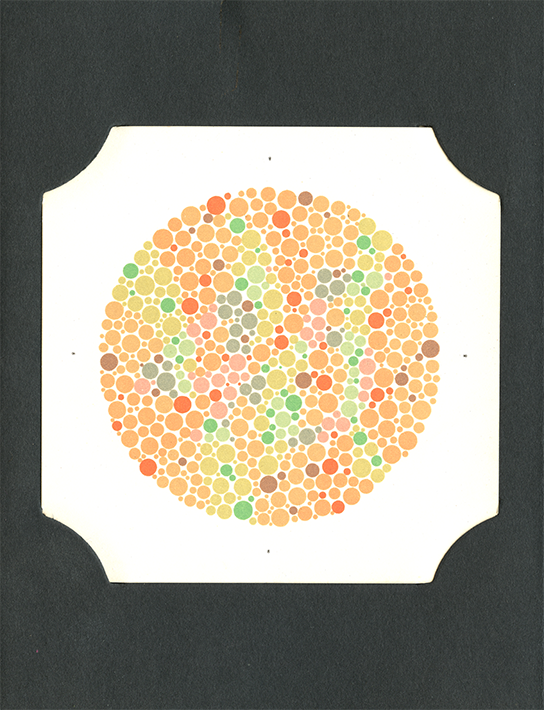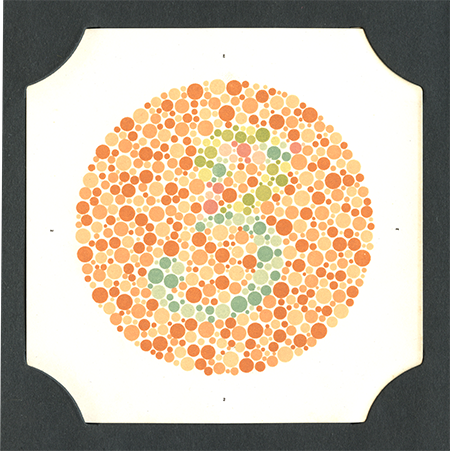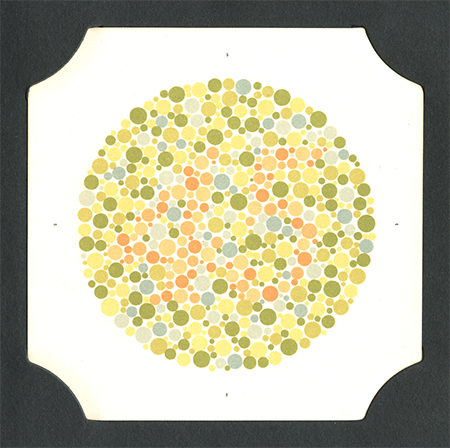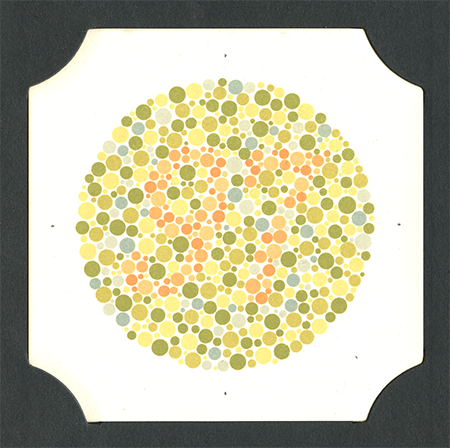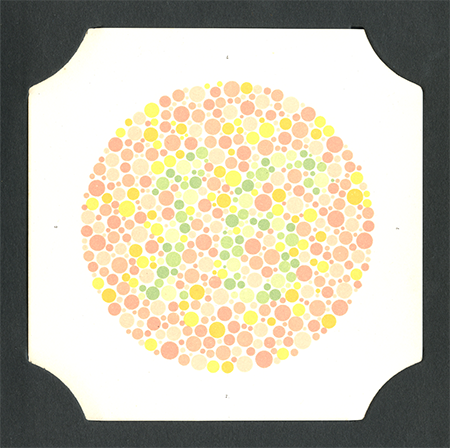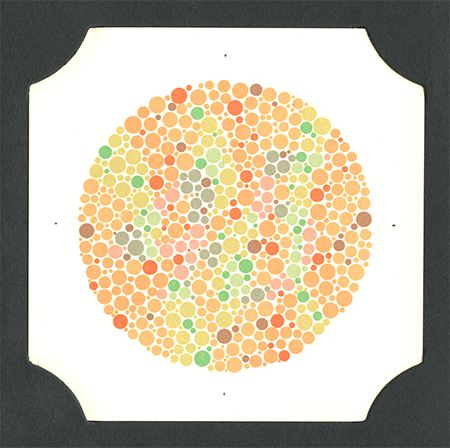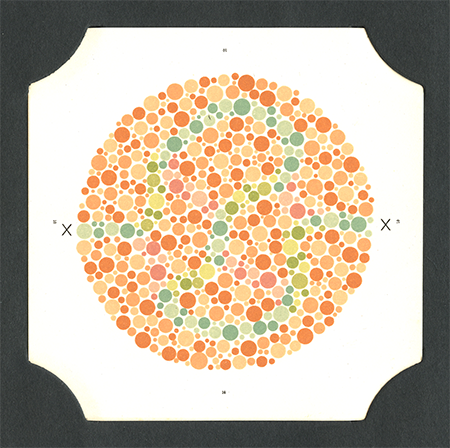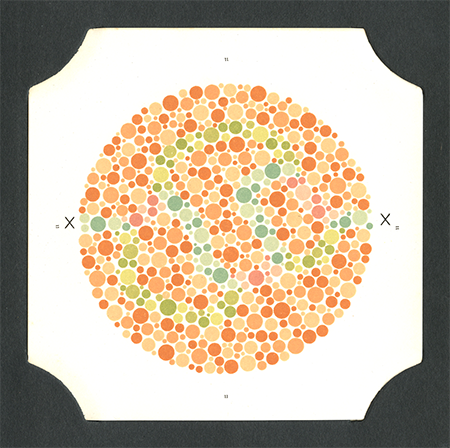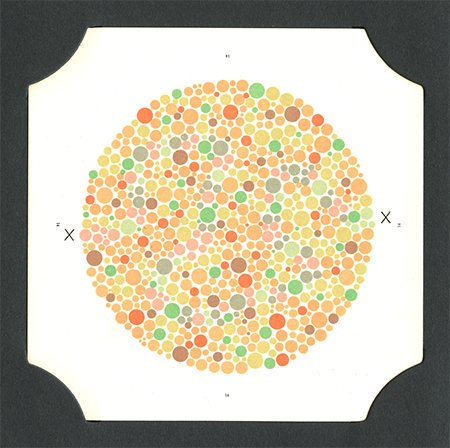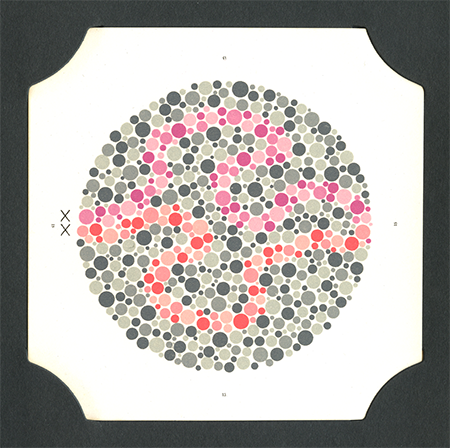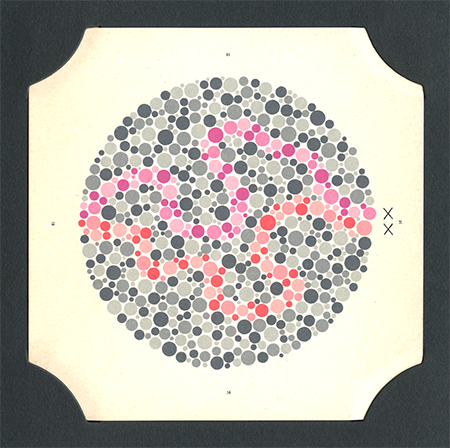72
Tests for Colour-Blindness
Shinobu Ishihara
This 4¾" square tipped-in plate, the eighth in a series of 16, is a hidden (or reverse) pseudo-isochromatic design intended to differentiate trichromatic from dichromatic vision.1 In other words – a color-blindness test. You have, no doubt, seen this before, and that’s not surprising. Although the chart looks modern, like a design from the op-art 1960s, it is nearly 100 years old.
Shinobu Ishihara 石原 忍 (25 Sep 1879 – 3 Jan 1963) graduated on a military scholarship from the Imperial University of Tokyo in 1905. In 1908 he began postgraduate studies in ophthalmology, first in Tokyo and, during 1913–14, in Germany. He received his Igaku Hakushi from the Imperial University in Tokyo in May 1916 and became a chief physician general in the Imperial Army. One of his first military assignments was to design a color-blindness for new recruits.
His first two sets of plates were hand painted watercolors that included “hidden” hiragana characters and were tested with a color-blind colleague. A third version, done in 1917, replaced the hirahanga with arabic numerals.
Plate 1.
Plate 2
Plate 3
Plate 4
The test consisted of numbers camouflaged in a random dot pattern that could only be discerned by hue. The results were easily interpreted and relatively accurate (at least for green-red color deficiencies). It was an exceptionally novel and elegant solution to the problem. A graphic design classic.
Plate 5
Plate 6
Plate 7
Plate 8
Ishihara realized that his numeral version could be used outside of Japan and he self-financed an edition of 600 copies. It, however, did not sell very well and he began sending copies to universities and ophthalmologists in Europe and America. His test was eventually accepted by the medical profession and in 1925 a joint agreement was reached between Handaya & Co., who would handle sales in Japan and Kanehara Shuppan Co. Ltd,. who would market an International Edition overseas.2
Plate 9
Plate 10
Plate 11
Plate 12
Ishihara would spend the next 50 years working on new tests, including children’s charts that relied on tracing paths instead of numbers. A complete set eventually included 36 plates, although reduced editions of 25 or 16 plates were also published. The scans here are from the 16-plate US edition of 1960.3
Plate 13
Plate 14
Plate 15
Plate 16
After his retirement from the Imperial University in 1940 Ishihara moved to a village on the Izu Peninsula where he continued to serve as a country doctor. Near the end of his life he was venerated as a Bunka Korousyo. After his death in 1963 the Isshinkai Foundation, endowed with the tests' royalties, assumed stewardship of his legacy and his test, which is still published today.
1. To explain color vision and it’s deficits let’s talk about molecular genetics – this will be fun! Normal vision requires two types of retinal cells and several different G protein-coupled photoreceptors, known as opsins.
Rhodopsin (or visual purple), in rod cells, is most sensitive (i.e λ max occurs) at ~500nm, and is responsible for night vision. It has nothing to do with color vision, so we’ll move on.
Blue-sensitive opsin in “S-type” cone cells is most sensitive at ~420nm. It is encoded by the gene OPN1SW (opsin 1 short wave) on chromosome 7q32.1. Green-sensitive opsin in “M” cones is most sensitive at ~530nm and is encoded by OPN1MW (opsin 1 middle wave) on chromosome Xq28. Red-sensitive opsin in “L” cones is most sensitive at ~560nm and is encoded by OPN1LW (opsin 1 long wave) on chromosome Xq28.
Red-green color vision defects (protanopia – lack of red-sensitive opsins or deuteranopia – lack of green sensitive opsins) are inherited in an X-linked recessive pattern and are passed on by the mother. Because women have two X chromosomes and men only one, the incidence of red-green defects are much higher in men (~8%) than women (~0.5%). ~15% of women are carriers.
Blue-yellow color vision defects (tritanopia), from the lack of blue-sensitive opsins are inherited in an autosomal dominant pattern. They affect men and women equally and are relatively rare. Here is a table summarizing all of this:

Notes on the table: mut = mutated opsin. * The red-sensitive opsin (λ max. ~560 nm, which is actually yellow-green) is shifted nearly 100 nm right to appear red, otherwise the table would be too confusing. ** The overall λ max of trichromatic vision (S+M+L) is about 540 nm (again yellow-green, or chartreuse), a fact exploited in the color of traffic signs and some emergency vehicles.
For more information see the NCBI's Gene Review article Red-Green Color Vision Defects or the textbook chapter Opsin genes, cone photopigments, color vision and color blindness.
2. Ishihara, Shinobu. Tests for Colour-blindness. Tokyo: Hongo Harukicho, 1917, or Ishihara, Shinobu. Tests for Colour-blindness. Tokyo: Kanehara Shuppon, 1925.
3. Ishihara, Shinobu. Tests for Colour-blindness (Reduced edition). Tokyo: Kanehara Shuppon, 1960. This US-only edition (no. S524B) was printed by San-ei, Ltd., Tokyo. The book consisted of 16 lithographed cards tipped into an accordion-folded, cloth-covered and slipcased book + a six-page paper booklet describing the plates. A beautiful, abeit expensive, presentation.
26 Sep 2010 ‧ Design
